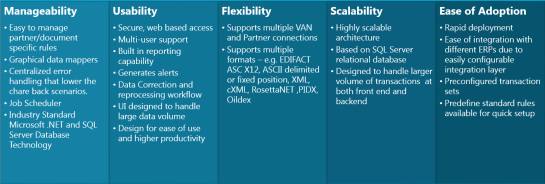Electronic Data Interchange Decoupled
Over 95% of all Electronic Business Transactions take place using EDI.
Implementing a new ERP system usually requires a new EDI module.
Picture yourself in the Indianapolis 500 driving the wining car on the final lap when all of the sudden your engine starts to shutter. The crew radios you to pull over into the pit stop and when you do your worst fear is discovered. You need to replace the engine. Game over…
EDI transition is an arduous task that can make or break any company. EDI is one of the KEY modules that needs to be thoroughly thought out at the beginning of the design phase. A “decoupled” approach can seamlessly change any ERP without the disruption of your Electronic Business Transactions.
The top 3 challenges for EDI Implementation:
- B2B Integration
The customer onboarding process is quite intense from the mappings to the required documents. The vendor standards manuals are constantly changing to meet the new requirements of the trading partners. You’re not just trying to hit one moving target, you’re trying to hit all the trading partners in a very short time. Also, If you have the need to change your sender/receiver id than you will have to go back to “testing” mode and start all over. - Tightly coupled
There are so many connections from ERP to EDI it is like being tethered down and no room to move. These connections are like a spider web. “Coupling, combine’s the contradictory concepts of connection and autonomy.” - Lack of visibility
How do I trace the problem back to a specific step without having to receive the document again? This can be one of the most frustrating tasks for an EDI manager. Why go back to the beginning if I can go back to where the problem occurred and fix from the specific step.
The ability to see the risks ahead will better prepare and overcome most challenges and align for a successful implementation.
Strategy, Tactics and Execution…
Now that the strategy is established with key risks, the tactics are clearly defined:
- Align business rules by customer for all aspects of pick, pack and ship
- Remove all unnecessary steps from previous EDI module
- Establish the SLA with the EDI software support team
- Build an alliance with the EDI trading partner support team
- Train, Train, and more training
- The “customer rules” can be aligned and setup one time with Partner Link and you can change ERP seamlessly without any disruption.
- The “Decoupled” approach aligns the EDI module autonomous from the ERP
- No need to change the EDI module when implementing a new ERP
- Cloud scalability

Once all of the pieces of the puzzle are in place the EDI will flow naturally. A reoccurring task is to update the vendor standards manuals for any changes that may take place over the course of time such as routing guides DC and Store additions or closings.
The execution of the EDI solution aligned with the required business rules will allow your EDI process to run smoothly along with KPI’s to alert with detailed information.
You are now prepared to win the EDI race with precision and accuracy.
Author’s Profile:
David Nocero
David is responsible for designing Visionet’s Supply Chain & WMS collaborative transformation approaches that optimize the architecture across the customer business requirements & constraints and current state technology platforms. David has been the business and technical leader on many EDI, PLM, ECOM, ERP, WMS and POS Global Supply Chain implementations over his 20+ year’s career. He has been responsible for all business and technical matters related to design, development, deployment and sustainment of many renowned companies.
Source: https://www.visionetsystems.com/blog/electronic-data-interchange-decoupled
